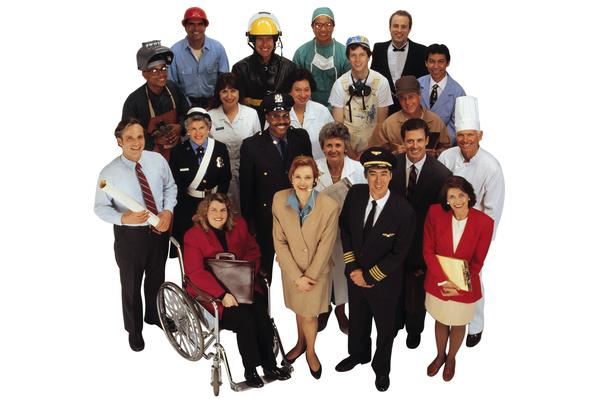Most government agencies understand the business case for diversity and equal employment opportunity (EEO).
It’s evident by now that diverse employees bring a broad range of ideas and viewpoints to the table which can promote positive change, spark innovation, increase productivity and maximize strategic mission-driven results.
This is particularly true as the nation and labor force are increasingly more diverse. According to the U.S. Census Bureau, Hispanics/Latinos and Asian Americans represent the fastest growing populations – a demographic trend expected to continue in the years and decades ahead.
Business Case for Diversity & EEO
A diverse workforce challenges “old-school” orthodoxy and antiquated thinking with fresh out-of-the-box ideas and new ways of working. This can subsequently improve the efficiency and effectiveness of mission-driven results, while also building a workforce which more closely resembles America.
- Fostering diversity and EEO can help government agencies improve recruitment, hiring, retention and advancement of the most talented employees – including minorities, women, people with disabilities, and the next generation of leadership.

Unfortunately, employment discrimination still remains an unwelcome scourge in the modern workplace – whether blatant or implicit, conscious or unconscious, intentional or unintentional. This is another reason why EEO and diversity programs are of utmost importance for all workplaces.
Uncle Sam knows this and has taken the lead in proactively promoting diversity and EEO at every agency. The U.S. Government understands that the best talent and ability can come from anyone and anywhere – regardless of race, color, gender, disability, religion, age, national origin, sexual orientation, etc.
Executive Order on Diversity & Inclusion
Executive Order 13583 was signed by President Obama in August 2011 to establish “A Coordinated Government-wide Initiative to Promote Diversity and Inclusion in the Federal Workforce.” The Executive Order reads in part:
- “Our Nation derives strength from the diversity of its population and from its commitment to equal opportunity for all. We are at our best when we draw on the talents of all parts of our society, and our greatest accomplishments are achieved when diverse perspectives are brought to bear to overcome our greatest challenge.”
- “As the Nation’s largest employer, the Federal Government has a special obligation to lead by example. Attaining a diverse, qualified workforce is one of the cornerstones of the merit-based civil service.”
- “To realize more fully the goal of using the talents of all segments of society, the Federal Government must continue to challenge itself to enhance its ability to recruit, hire, promote, and retain a more diverse workforce.”
- “Further, the Federal Government must create a culture that encourages collaboration, flexibility, and fairness to enable individuals to participate to their full potential.”

Much Work Remains
While federal agencies have made substantial progress over the years in the areas of diversity and EEO, much work still lies ahead.
Unfortunately, diversity shortfalls at the highest levels of government remain an unwelcome reality for feds who are minorities, women, as well as people with disabilities and “targeted disabilities” (the most severe impairments).
Minorities and women remain under-represented in the Senior Executive Service (SES) and top grade levels government-wide. Hispanics have been under-represented overall for some time. Moreover, minorities and women are too often clustered into mid-level or low-level grades with little room for significant advancement.
So what can federal agencies do to further improve diversity and advance EEO as a strategic imperative? Following are five suggestions:
- Closely collaborate with OPM to implement and better leverage diversity and inclusion best practices, in accordance with Executive Order 13583 and other executive actions.
- Partner more closely with EEOC to receive the necessary education, technical assistance and training to maximize equal opportunity and promote model workplaces for all individuals.
- Display more leadership from the top. Agency heads need to clearly communicate the importance of diversity and EEO in a more sustained manner. This message is always most effective when it comes from the head of the organization.
- Increase mentoring of women, minorities and people with disabilities. It’s simply not enough to recruit and hire a diverse workforce, but just as important to improve retention and advancement. Mentoring plays an invaluable role in this regard.
- Don’t discriminate, period! Providing equal opportunity means all federal employment decisions – with the exception of political and presidential appointees – should be based strictly on merit, talent and ability to do the job. Every individual deserves the chance to compete and advance on a fair and level playing field without discriminatory barriers. That’s what justice and equality are all about.
The Takeaway
Despite building the most diverse workforce in America for an organization of its size, Uncle Sam still faces some glaring problems.
There are still too many glass ceilings, sticky floors and clogged pipelines, so to speak. This unjustly holds back talented public servants from reaching their full potential based on merit.
This simply cannot stand if the federal government truly aspires to be a model employer for all individuals.
DBG
AUTHOR’S NOTE:
This is the second of a five-part series examining top priorities for public sector agencies in 2015. Last week, I addressed the issue of cybersecurity as the #1 priority for the public sector.
The importance of enhancing cybersecurity was further exemplified Monday by three separate events:
1) The rogue hacking of some social media accounts of U.S. Central Command (CentCom).
2) Federal News Radio and other media reported that OPM has “disabled a Web portal used by federal retirees Monday to address a malfunction that may have left some retirees’ information accessible to other individuals visiting the portal.”
3) Finally, a scathing GAO report made public on Monday identifies some major deficiencies in cybersecurity government-wide. The report is highly critical of the Department of Homeland Security (DHS).
- Stay tuned next week for public sector priority #3 for 2015. Meanwhile, please share your valuable views and important insights in the comment section below. Make YOUR voice heard…
PLEASE NOTE: All views and opinions are those of the author only and not official statements or endorsements of any public sector employer, private sector employer, organization or political entity.
David B. Grinberg is part of the GovLoop Featured Blogger program, where we feature blog posts by government voices from all across the country (and world!). To see more Featured Blogger posts, click here.





FYI – I also spoke to two former chairs of the EEOC for this post to get their take on diversity issues.
Gilbert Casellas was EEOC Chairman during the Administration of President Bill Clinton, in addition to serving as General Counsel of the Air Force. He has also held top executive management and leadership positions in corporate America and sits on corporate boards. He told me this:
“The singular greatest strength of the US is that we are a diverse society, comprised of individuals of many backgrounds, races, languages, ethnicities, religions and abilities. Smart employers — whether of the public or private sector — can only address and overcome the complex
challenges they face each day by drawing broadly on these diverse skills, perspectives and experiences.”
Cari Dominguez chaired the EEOC under President George W. Bush, in addition to serving as Assistant Secretary of Labor. She has also held executive management and leadership positions in corporate America. She has this to say:
“The US military, while not perfect, has been, for years, the most diverse institution in our Nation. Statistics and reports serve to inform, but it is leadership what drives results. Developing individuals of all backgrounds into leaders achieves results. Leadership is not rank, privileges, title or money; it is responsibility and results. It is up to the leadership of each agency at every level to set a firm standard and hold others accountable for results. Indeed, the federal government needs to pay more attention to its leadership corps to ensure a strong and diverse workforce and a healthy workplace.”
WHAT DO YOU THINK?
Dear David,
Thank you for this most excellent an expert analysis of the situation facing the sector.
So true to that many of the EEO leaders from the past two decades inside the beltway have retired or are in the process that I would care to share for public commit my take on the current state of this item. Why well it has been a so often overlooked topic for the HR community and as that in and of itself is one of five basic areas that include #STEM Talent in Public Health, HR, CYBER, Civilian Acquisition Careers not to mention the need for Diversity it is my friend but one of lifes daily with challenges that can if we think on it allow for new opportunities to unfold. Thinking about being #REDI Recruitment, Engagement Diversity & Inclusion too, and in addition to EEOC, MSPB, OPM.
So very true and as a Gen X cusper that two white guys lookin
Thanks for the valuable feedback, John, which is very much appreciated!
From a diversity standpoint, one of the most critical areas of need for the acquisition workforce is to hire talent that have the business and critical thinking skills necessary to execute the contracting and acquisition mission.
I wrote about this need over 5 years ago, and the need has only intensified:
http://fcw.com/Articles/2009/05/04/Comment-wide-net-for-talent-recruiting.aspx
Jaime, thanks for sharing you unique insights regarding how diversity applies to the contracting and acquisition mission. Thanks also for sharing the link to your excellent post, which I advise folks to read.
Check out http://www.DiverseCEO.com magazine upcoming interview with USDA’s head of employment and the unique strategies they are employing related to diversity. Some interesting tactics and results to be proud of regarding diversity in the US Federal Government.
Need a Diversity Recruiter – only the best — Torin Ellis.
Find him here: https://www.linkedin.com/pub/torin-ellis/2/70a/416
Thank you,
Jennifer Schaus
Govt Contractor Support Services
http://www.Jenniferschaus.com
Jennifer, your valuable feedback is appreciated! Thanks so much for sharing that excellent information along with the web links.
I think the great advantage that young people today have over others throughout the world is that America embraces diverse people and the ideas they bring into the workplace. Overall, I would give America a “C” or average grade. We are doing an OK job at embracing diversity, but we are going to have a workforce that really sparks innovations then we’ve got to increase our efforts for embracing diversity.
Thanks for sharing your important insights, Dr. Johnson. Nicely put, although I would go with a grade of “B” for the federal workforce and C-minus for the private sector.
The quote from Gilbert Casellas, the article itself, superb contributions to the conversation. Excellent read!
Your positive feedback is very much appreciated. I’m glad you liked the quote above from Gil Casellas above. Many thanks for sharing your thoughts!
It seems reasonable to assume given the statistics and awareness surrounding executive order 13583 (now 3 years old!) that the true concept of Diversity & Inclusion would be apparent and more readily adapted across government agencies – yes, beginning with OPM. However, we have come up painfully short in this regard and it is simply unacceptable at every level.
Thanks for the valuable feedback, Cristina, it’s great to hear from you! I agree that more progress is certainly needed, especially within the SES and upper grade levels. But agencies gov-wide need to follow the Executive Order and work closely with OPM to implement it. The agencies play a major role in determining the diversity of their individual workforces via recruitment, hiring, retention, training and advancement. Thus, I think agency heads and HR offices really need to step it up. Thanks again!
Another imperative for organizations to think about when looking to foster diversity and inclusion is strategically leveraging workplace flexibilities, telework and other supportive workplace programs. While traditionally thought of as “soft” benefits and employee “perks”, these programs and policies can help overcome many of the socio-economic barriers that exist in attracting and retaining talent from diverse backgrounds and locations. The beauty is that these are easy and low cost incentives to offer- as long as the supervisors and culture are equipped with the skills needed to effectively manage performance, demonstrate accountability and focus on results in ANY workplace environment. You stated these benefits nicely in your recent post on Workplace Flexibility as well David! Thanks for sharing: https://www.linkedin.com/pulse/expanding-work-flexibility-3-business-priority-2015-david-b-grinberg?trk=prof-post
Mika, thanks — as always — for your exemplary feedback. Next week’s post for GovLoop will focus on work flexibility as the #3 priority for the public sector.
First of all, I would like to thank David for writing this article highlighting priorities for 2015. The series of articles provide a valuable opportunity to engage in a dialogue regarding trends that are impacting the health of organizations
Many of my Federal government and Fortune 1000 clients recognize the importance of developing work environments that help support the recruitment and retention of a diverse workforce.
Several issues remain significant and have helped facilitate actions; including:
• Unconscious bias: recognizing that all of us have bias, and taking steps to help everyone understand their bias, the impact of such biases and how to reduce their impact in decision-making
• Understanding how to engage white men in the conversation about diversity: Many people either forget or neglect the diversity among white men, and sometimes underestimate the impact of not including white man in the conversation about diversity
• Multigenerational workforce: The five generations at work today provide some unique challenges to the workforce of today; including how to address the different learning styles of the multigenerational workforce and how to enhance communication between members of the different generations at work
What to do?
Taking steps to enhance workforce diversity is not a nice-to-have but a business imperative. Some steps organizations are taking to deal with the issues highlighted above and others include:
• Training and development: there continues to be an opportunity to identify specific skill gaps and offer a combination of training and coaching to help develop specific skill. While
• Mentoring; provides a unique opportunity to build a support group for a diverse workforce. I’ve seen organizations effectively implement mentoring programs to support diversity initiatives and/or use mentoring as a way to enhance the on boarding process — as a tool to increase the engagement and retention of a diverse workforce.
• Measurement, ROI and communication: most savvy employers recognize the business case for diversity, there remains an opportunity to enhance the communication of the business imperatives of supporting a diverse workforce and to demonstrate the return on investment from taking steps to build a diverse workforce.
I look forward to reading other people’s perspective regarding their top priorities for 2015 and learning about what other organizations to address workforce diversity, and other organizational challenges.
Ken, thanks so much for sharing your important insights. You raise several excellent points. I think more private sector organizations must view workforce diversity as “business imperative” (as you point out), especially as the nation and labor force become increasingly more diverse. Thanks again for valuable feedback on this topic, which is very much appreciated!
For the D.C. area (where majority fed jobs take place), the Federal Workplace is ABSOLUTELY NOT DIVERSE and does not represent America. It appears that region’s direct-payroll fed workforce is “biased” towards emplying three groups: Veterans (some w/ questionable skills but hired due to “entitled preferences”); Persons under age 40; Persons who grew up in the Northeastern USA or orig. from a 250 miles N, E, W (but rarely South) of the “District.”
Love to see much more NON-vets, persons over age 40 and widely differing geographic parts of USA be hired to work the DC region. After several years of use, I think USAjobs.gov website is a JOKE! -very inefficient, supports a culture of “elitist” hires by DC-based agency heads who know little about most of the 50 states, but a LOT about NY State, VA, MD, PA, Jersey. Add my complaints among myriad of reasons why many Americans that are not from nor live in the “up East” Wash-NYC corridor (be they liberal, conservative, Democrat, Republican, rich, poor, of different colors) HATE Washington and the mentioned HR hiring “locals only” discrimination culture agency heads still stubbornly support.
Belated thanks for the valuable feedback, Steve!